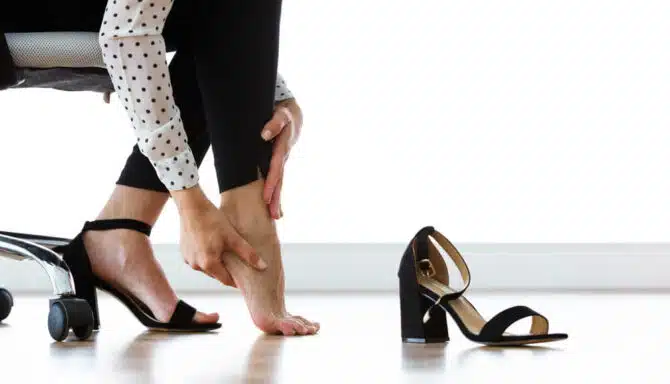Numb toes are an intriguing phenomenon. Unlike so many foot conditions where pain is the symptom, numbness is the absence of feeling. And while a numb sensation may not be cause for concern, there are certain instances where it can be damaging.
The most common cause of numb toes is compression. By this, compression means the act of pressing something into a smaller space or putting pressure on it. Typically, ill-fitting footwear or a narrow toe box can put undue pressure on your toes. Given the fact that we wear shoes for hours on end, one can understand how continuous compression can have a negative effect.
Toe numbness can be a cause of concern, but rarely a medical emergency. If you experience numb toes on isolated occasions, continue to monitor your feet. If, however, a numb sensation is a regular occurrence, contact a medical professional for possible causes.
Numb Toes: Why/How Do They Occur?
There are a number of causes to a numbing sensation in your toes. From improper footwear to a serious disease like diabetes, there is a broad range of factors to consider. Below you’ll find a comprehensive list to why you may be experiencing numbness to your toes.
Are Numb Toes A Sign Of Diabetes?
High sugar and fats in your blood can cause your toes to go numb. Poor circulation to your toes causes a numbness sensation as it limits blood supply to the region. The condition that causes damage to your nerves as a result of diabetes is called diabetic neuropathy.
First and foremost, ask your doctor to check your blood sugar levels to see if diabetes is the cause. Additionally, you can
- Check your toes regularly (i.e.: daily);
- Moisturize your feet;
- Take care of your toenails, and consult a podiatrist for a plan of action;
- Wear proper footwear.
Morton’s Neuroma
Morton’s Neuroma is a type of nerve compression syndrome which involves nerves in the smaller toes. The pressure on that nerve may cause pain in the ball of your foot. Nerve compression can also lead to numb toes.
Like metatarsalgia (see below), common ways to reduce and prevent Morton’s neuroma include proper orthopaedic footwear, custom foot orthotics, rest (from any repetitive activity like running and jumping), and icing.
Metatarsalgia
Metatarsalgia, a term used for any pain found in the ball of the foot, can bring a numb sensation in the toes. Typically, pain starts in the ball of the foot, but like with many foot conditions, the end result can be in another part of the foot. In this case, the toes.
Causes of metatarsalgia are typically specific to overuse. For example, long-distance runners often suffer from metatarsalgia because of the constant pressure to the ball of the foot. However, the shape of your foot may also play a role. High arches, bunions, and curled toes can be a primary, or secondary cause of metatarsalgia.
How do I get rid of numbness in my toes?
- Swap out shoes
- Custom foot orthotics
- Rest
- Icing
If numbness or pain persists, contact us to book an appointment.
Raynaud’s Phenomenon
Raynaud’s Phenomenon is a condition of discolouration of the toes after exposure to changes in temperature (cold or hot) or emotional events. This condition is apparent because of its visibility. Your toes may turn white, then blue, and then red as blood flow diminishes, and then resumes.
According to WebMD, there are two types of Raynaud’s Phenomenon: primary and secondary. Primary occurs by itself, and the cause is unknown. Primary is usually harmless. But secondary Raynaud’s is linked to diseases that affect your autoimmune system, like Rheumatoid Arthritis or lupus.
Why does discolouration occur? There is an abnormal spasm of the blood vessels causing diminished blood flow to the toes.
Frostbite
It’s around that time of year again. Temperature plummets, and the risk of Frostbite does the opposite—skyrockets. Frostbite is an injury caused by freezing of the skin and underlying tissues. Your toes are particularly susceptible to frostbite, which begins when your skin becomes cold and red, then numb, then hard and pale.
The challenge with frostbite is that it starts out as frostnip. Numbness reduces sensation in the toes, and hides discomfort and nerve damage. If not addressed, frostnip can lead to superficial frostbite followed deep frostbite, the most severe of the three stages.
To prevent frostbite from occurring, taking the following precautions:
- Wear moisture-wicking socks that fit correctly, and have insulation
- Change out wet socks as soon as possible
- Watch for early signs of frostbite like red skin, or numbness
- Keep moving: encourage blood flow to the area
Check out our complete guide on How To Protect Your Feet This Winter.
Beriberi
Beriberi is a disease caused by a vitamin B-1 deficiency, also known as thiamine deficiency, according to Healthline.com. Specifically, dry beriberi is a concern for your toes, as the condition damages the nerves. The primary cause of beriberi is low thiamine. Those with a rich and well-balanced diet aren’t at risk; those with an alcohol disorder, for example. are at higher risk.
Common symptoms include decreased muscle function, pain and tingling, and loss of feeling in the toes. Fortunately, one can prevent beriberi by following a vitamin-enriched diet, if thiamine deficiency is the cause.
Peroneal Nerve Injury
Peroneal nerve injury and its association with numb toes is a fantastic example of treating the cause, not the symptom. The peroneal nerve branches from the sciatic nerve and provides sensation to the front and sides of the legs and to the top of the feet. However, what you may not know is that the nerve controls the muscles in the leg that lift the ankle and toes upward, according to John Hopkins Medicine.
An injury to the peroneal nerve can affect its ability to control the muscles in the toes, leading to a numbing sensation. Or worse, a sharp pain. Typically, injuries to the nerve include trauma to the knee: fractures, sprains, dislocations, and surgery. Common symptoms of a peroneal nerve injury include:
- An inability to point the toes upward or lift the ankle up
- Numb or tingling toes
- Reduced ability to move the foot
If you think you may have an injury to your peroneal nerve, consult a medical professional for a proper diagnosis.
Toe Deformities
Toe deformities, like Bunions, can also put uneven pressure on your toes. This skeletal deformity for example can put pressure on the outside of your feet.
Experiencing Numb Toes? Have No Fear!
We have all your solution under one roof. Open 6 days a week, we’ll be happy to help inform you and solve all your concerns any day at your convenience! Call us at 416-769-3338 or Book Your Assessment Today!













